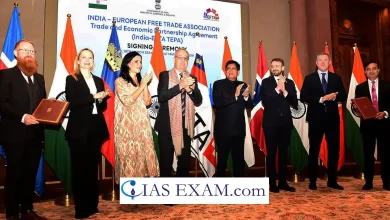E-Waste Management and Recycling in India
[GS Paper 3 – Conservation, Environment Pollution and Degradation]
Context – Attero Recycling, one of India’s largest electronic waste management companies, is set to invest close to $1 billion in expanding their electronic waste recycling facilities in India.
About E-waste Management
- E-waste management is a complicated process given the multitude of actors that are involved in the process.
- The major stakeholders in the value chain include importers, producers/manufacturers, retailers (businesses/government/others), consumers (individual households, businesses, government and others), traders, scrap dealers, dissemblers/dismantlers and recyclers.
- To critically assess each in the different stages of processing, it is important to understand the e-waste value chain.
- The process involves four stages: generation, collection, segregation and treatment/disposal.
E-Waste Regulatory Ecosystem in India
- The Indian electronics sector boomed in the last decade. Increased production and penetration of imported electronics items led to an accelerated e-waste generation that necessitated regulatory control over the sector.
- India has Electronic Waste (Management and Handling) Rules 2011 in place since . Its scope was expanded in 2016 and 2018 through amendments.
Provisions of E-Wastes Rules 2011
- To streamline e-waste management, the Government introduced Extended Producer Responsibility (EPR) whereby producers were required to collect and recycle electronic items.
- Since manufacturers were incurring the disposal cost, their designs would incorporate less toxic and easily recyclable materials, thereby reducing input material requirements.
Fundamental flaws in Implementation
- Recycling – Less than five percent of the waste is treated through formal recycling facilities.
- Informal sector – The rest is handled by the informal sector with very little enforcement of environmental and occupational safety norms.
- Weak Regulations – A deeper analysis revealed that the EPR regulations in India were not quantified through collection or recycling targets as in other countries with better implementation framework and mechanisms.
- Lack of incentivization – In the absence of targets, producers had little incentive to ensure the collection of their used products.
Challenges in E-Waste Recycling
- Crude and Scrappage – As of today, some 95% of e-waste is managed by the informal sector which operates under inferior working conditions and relies on crude techniques for dismantling and recycling.
- Infrastructure lacunae – Another important issue is the lack of sufficient metal processing infrastructure which is why recyclers have to export materials to global smelters.
- Price competencies – As aggregators are mostly informal, they demand up-front cash payments.
- Bloomed informal network – The informal network is well-established and rests on social capital ties that PROs have yet to establish and are hence insulated from reaching the viable number of aggregators.
- Policy failure – Policy changes have tried repeatedly to formalize the sector, but issues of implementation persist on the ground.
Way forward
- Effective design – Since India is highly deficient in precious mineral resources, there is a need for a well-designed, robust and regulated e-waste recovery regime that would generate jobs and wealth.
- Consumer responsibility – The consumers must responsibly consume the product for its useful life and then weigh between the chances of repair or disposal with utmost consciousness towards the environment.
- Recyclable products – On the supply side, e-waste can be reduced when producers design electronic products that are safer, and more durable, repairable and recyclable.
- Reuse – Manufacturers must reuse the recyclable materials and not mine rare elements unnecessarily to meet new production.
- Commercial recycling – Rather than hoping that informal recyclers become formal it would be more feasible for companies and the state to design programs to ensure e-waste easily makes its way to proper recyclers.
Conclusion
It is needed to come up with a strategy to engage with informal sector workers because doing so will not only go a long way in better e-waste management practices but also aid in environmental protection, improve the health and working conditions of laborers and provide better work opportunities to over a million people. This will make management environmentally sustainable and easy to monitor.





.png)



